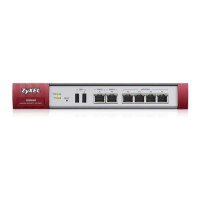ZyWALL 5 User’s Guide
Chapter 2 Introducing the Web Configurator 59
Click MAINTENANCE to view information about your ZyWALL or upgrade configuration/
firmware files. Maintenance includes General, Password, Time and Date, Device Mode, F/
W (firmware) Upload, Configuration (Backup, Restore, Default), and Restart.
The following table describes the labels in this screen.
Table 2 Web Configurator HOME Screen in Router Mode
LABEL DESCRIPTION
Wizards for Quick
Setup
Internet Access Click Internet Access to use the initial configuration wizard.
VPN Wizard Click VPN Wizard to create VPN policies.
Device
Information
System Name This is the System Name you enter in the MAINTENANCE General screen. It is for
identification purposes.
Firmware Version This is the ZyNOS Firmware version and the date created. ZyNOS is ZyXEL's
proprietary Network Operating System design.
Routing Protocol This shows the routing protocol - IP for which the ZyWALL is configured. This field is
not configurable.
Device Mode This displays whether the ZyWALL is functioning as a router or a bridge.
Firewall This displays whether or not the ZyWALL’s firewall is activated.
System Time This field displays your ZyWALL’s present date and time.
Memory The first number shows how many kilobytes of the heap memory the ZyWALL is
using. Heap memory refers to the memory that is not used by ZyNOS (ZyXEL
Network Operating System) and is thus available for running processes like NAT,
VPN and the firewall.
The second number shows the ZyWALL's total heap memory (in kilobytes).
The bar displays what percent of the ZyWALL's heap memory is in use. The bar
turns from green to red when the maximum is being approached.
Sessions The first number shows how many sessions are currently open on the ZyWALL.
This includes all sessions that are currently:
• Traversing the ZyWALL
• Terminating at the ZyWALL
• Initiated from the ZyWALL
The second number is the maximum number of sessions that can be open at one
time.
The bar displays what percent of the maximum number of sessions is in use. The
bar turns from green to red when the maximum is being approached.
Network Status
Interface This is the port type. Port types are: WAN, Dial Backup, LAN, WLAN and DMZ.
Click "+" to expand or "-" to collapse the LAN and DMZ IP alias drop-down lists.
Status For the LAN and DMZ ports, this displays the port speed and duplex setting. For the
WAN and Dial Backup port, it displays the port speed and duplex setting if you’re
using Ethernet encapsulation and Down (line is down or not connected), Idle (line
(ppp) idle), Dial (starting to trigger a call) or Drop (dropping a call) if you’re using
PPPoE encapsulation. For the WLAN port, it displays Active when WLAN is
enabled or Inactive when WLAN is disabled.
IP Address This shows the port’s IP address.

